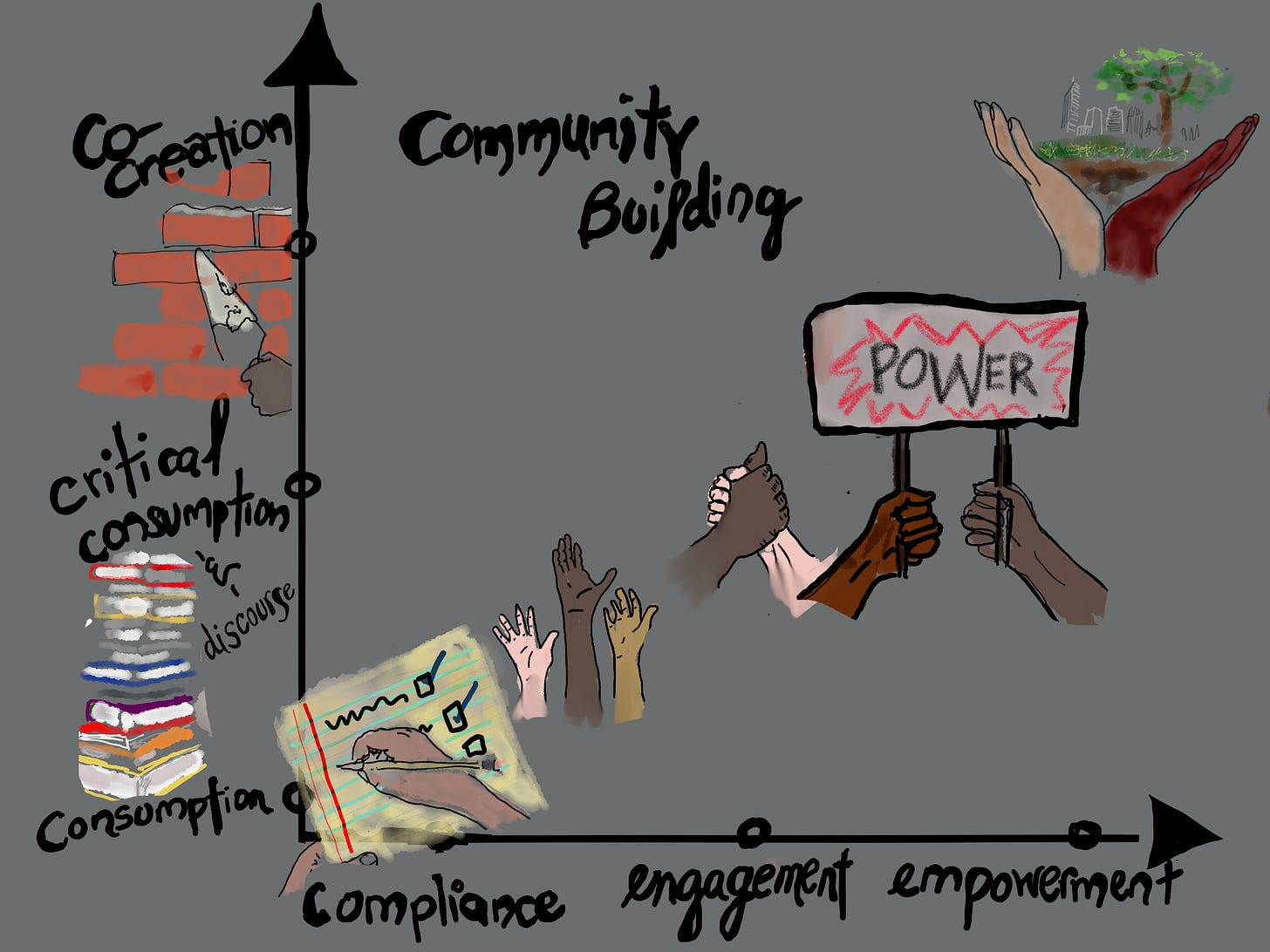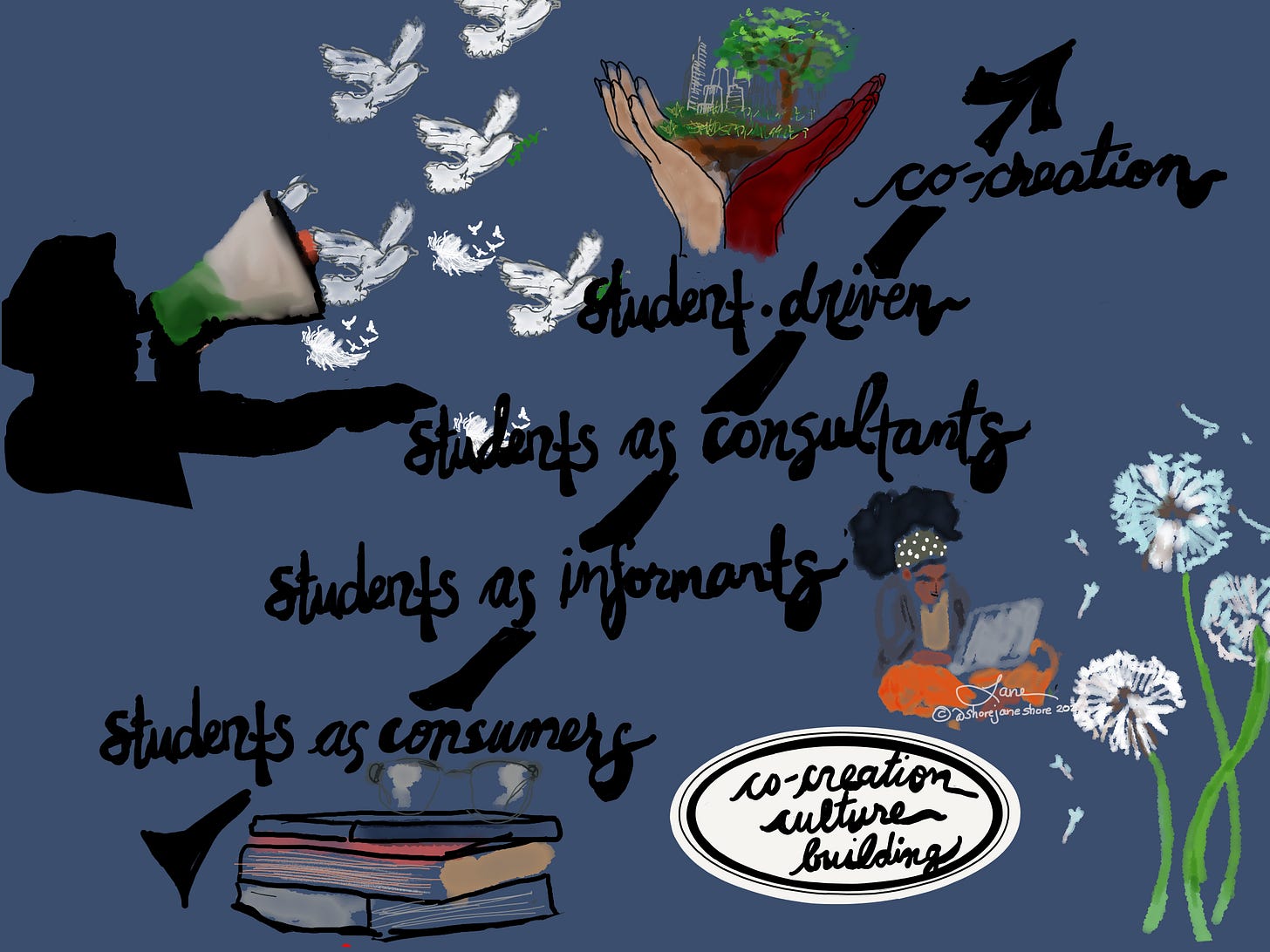We can only solve for the future if we are equipped with both knowledge and creative experience in the present.
Traditionally, students are trained to consume knowledge, to share it back in various formats (usually tests) as a demonstration of what they know.
And consumption, learning lots of new things, is important. Consumption can lead to creativity. You need experiences and knowledge as a starting point. But that doesn’t always happen.
Students may spend hours staring at interesting YouTube videos without ever taking a creative leap. Adults may go to engaging workshops, but never take the learning into their own practice. In life we can be inspired but not take the next step. But why does this happen?
It turns out, we all need to be more than just consumers. There is a step between consuming and creating and that is, we need to be critical consumers.
The message that schools, work and life sometimes does not provide:
We need to consume critically to create.
It’s not just the creation of knowledge that needs to happen. We all need to feel the power of influence. We cannot hold meetings in which individuals (students, employees, friends, community) share their creative, impactful stories, they voice ideas, solutions, and then we continue to carry on with business as usual.
If we want to bring out the best of our inner brilliance, to encourage creative thought as well as factual content, shouldn’t creativity be more fundamental, more tangible than this? Shouldn’t it be the rule, and not the exception?
We present….
A Co-Creativity Model
There’s an iterative cycle that starts at consumption and moves to critical consumption.
This is the INQUIRY piece- all about asking questions and seeking out new ideas. In learning, there is a curation of information, geeking out about an idea, a study, the topic, the craft.
This leads to igniting a sort of INSPIRATION. It requires a mix of new knowledge and some daydreaming. This might mean exploring, viewing, a sort of mash-up of colors, ideas, theories, visions, OR taking a different angle or a fresh perspective to a problem. Often, a plan and design emerge.
This, in turn, leads to fueling IMPROVISATION that leads to creative work. But sometimes this is about play and experimentation through trial and error that feels right. This could involve solving a problem, creating art, building a system, or planning an event. It’s all about imagining and trying out new things.
George Couros highlights this connection in his blog when he references the article, “Jazz musicians can teach surgeons how to improvise“:
In learning communities, we need space for all three of these to happen.

Only when pedagogy acknowledges creation and co-creation–not just being creative, but actually new ways of thinking and doing–as the very basis of deep learning will we be able to say we’ve made this shift. Deeper engagement, and the development of entrepreneurial, critical, collaborative and creative skills are considered to be positive outcomes of allowing students to take control of their own learning, so that they may set their own goals and design ways to meet them. It is only through this disciplined approach that learning settings can truly represent new ideas and knowledge.
Co-Creation Culture
All students need validating, sustainable, opportunities to make decisions about their own learning and education as a whole. This begins with culture.
Without a culture of co-creation, when provided with opportunities to make significant decisions about their schools, students tend to parrot teachers and others; frequently saying what they think adults want to hear. And many schools actively promote this approach in their student governments, allowing student voice to come in for decisions like the school mascot, colors, or other fairly inconsequential practices, but not giving them real voice in decisions that have more serious implications, like schedules, evidence of learning and hiring of teachers.
What does the research say? Here are a few positive outcomes that come from such co-creation:
Improved student motivation, academic persistence and achievement
Student initiation of connections with the community and the world
Greater connections among students as they create for a joint goal
More celebration, burstiness in sharing ideas and constructive criticism
This idea represents a shift in tradition. But identifying places in school program and curriculum, policy, and climate that can provide more meaningful creativity, presentation of ideas and direction, leadership areas for students can provide a true culture of co-creation, and ultimately benefit all.
How do we make CO-CREATION OF SCHOOL happen in real settings?
What does this look like? The Case of Report for America
By Rachel Rohr, Director of Training and Service for Report for America
This idea of creation versus consumption is actually at the heart of the volunteer projects at Report for America. We ask every journalist in our national service program to spend two to three hours a week supporting the media literacy of young people in their local community. But instead of doing presentations about fake news, our reporters and photojournalists support students in creating their own work — documenting the stories around them. This can take many forms: advising a school newspaper, teaching photojournalism at an after-school program, starting a teen podcast at the library, even helping to create murals or music videos that tell community stories. Whenever possible, the projects use equipment the students already have access to, sending the message that you don't need expensive professional gear to share your story. In the process of working with an RFA journalist, the students learn about storytelling, verifying facts, representing different perspectives. In all cases, the students' work is meant to be shared with the community. In some cases, our journalists (we call them "corps members" in the spirit of other national service programs) are able to get student work published by their news outlets.
Some additional benefits of the service projects include:
Elevating and sharing work by young people, whose voices are often marginalized
Helping young people develop useful and transferable skills, including critical thinking and empathy
Building trust in journalists and journalism, and increasing the number of Americans who have met a journalist
Allowing corps members to take off their reporter hat and connect with the community in a different way
Allowing corps members to hear the perspectives and experiences of young people, who they don't necessarily talk to in the course of their reporting
For more information on Report for America, contact Rachel Rohr at rrohr@reportforamerica.org
For insights from an enthusiastic school in partnership with Report for America, contact Dr. Jane Shore at jane@revolutionschool.org
As SchoolRetool asks, how might you hack this idea?
Some ideas collected from some amazing innovator/hacker/educator world busters:
Begin every learning experience with a period of creative expression. Inspo here.
Require creation in every project or assignment. Here is an amazing KQED resource to help, and TED offers some great examples.
Have students create products (or raise awareness on an issue) with and for other students. Ideas here.
Invite students to participate in staff meetings, hiring, health and safety policies, teacher evaluations.
Collaborate with students on program design, development and execution.
Sit aside students to create and execute upon assessment practices. Check these ideas out.
Engage with students as change agents in real work outside of school. Ideas here.
Create spaces for students to connect with community mentors (not just guests). Resource guide and ideas here.
Shout out to Linda Amici, Deb Borden, Henry Fairfax, Wendy Furry, John Lavin, Donna Lowber and Mike Pardee for the inspiration behind these ideas.
We’d love to hear your thoughts so keep on sharing posts, articles, or other initiatives that resonate with this week’s theme so we can all continue learning.
FORWARD this post to invite friends, colleagues or connections to join us.
SHARE what you learned. Not only does it help improve retention, but it also leads to ACTION.
ENGAGE On Twitter, tag us @Rvltnproject and use any of the hashtags #learnsomethingneweveryday #schoolofthought #creationANDconsumption❤️
Check out last week’s School of Thought post on the importance of daydreaming in learning and creating.
And next week, open up more thinking about creativity and well being.






